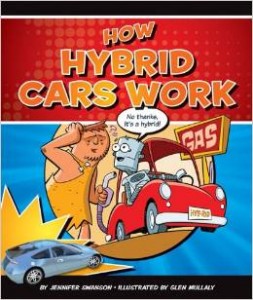Age Range: 6 and up
Grade Level: 1 and up
Series: Discovering How Things Work
Library Binding: 32 pages
Publisher: Child’s World; 1 edition (August 1, 2011)
Language: English
ISBN-10: 1609732170
ISBN-13: 978-1609732172
Non-Fiction
REVIEWS:
Combining the popular subjects of environmentalism and new technology, hybrid cars make for an ideal topic for middle-grade readers. This volume in the How Things Work series is bouncy, savvy, and, above all, clear; it is hard to come away without a working knowledge of everything from the mechanics of hybrid engines to why dependence on foreign oil is bad. Hosting the series are two cartoons - a robot and a caveman - especially apt choices for a book couched in the concept of discarding old energy sources for new. (When the caveman plugs his PHEV car into one of the robot's sockets, the robot deadpans, "This is humiliating.") A four-page time line explains the history of the concept, while bright cutaway illustrations show how the hybrid saves gas and how a fuel cell converts hydrogen gas. But the main event is Swanson's gift for making complicated subjects crystalline. To explain greenhouse gases, she compares them to the heat that builds up inside a parked car because of the glass windows - a swift, germane metaphor. The back matter is a bit skimpy, but otherwise this is a model of how to make science appeal to young readers.
**Booklist -- Starred Review **
Booklist - Daniel KrausJanuary 9, 2015
This vibrantly–illustrated book on hybrid cars, one of a series of 13 on "How Things Work," is very informative, with a relevant message for our society. The author (a middle school science teacher) explains greenhouse gases and global warming at an appropriate level, then connects the information to the importance of hybrid cars.
The book begins with a child and parent leaving for soccer practice. The mom must first check the battery and the hydrogen level of the car before they leave their home. The remainder of the book is divided into interesting fact–filled sections. There is a labeled diagram of a hybrid car in the text as well as a page listing the benefits of a hybrid car. An entire section which details how a hybrid car works will be very helpful to students and teachers. There is also a list of the four most popular hybrid cars on the market.
The book is not text–heavy so it will be an easy and quick read for students. There are great nonfiction features in the book, such as a wonderful timeline which begins in 1769 with the first steam–powered carriage built in France, and ends in 2011 with more than forty hybrid cars around the world. A neatly illustrated comic book style “Table of Contents”, index, glossary, and “Find Out More” section complete the book. Teachers can use the book as a supplement to a unit, librarians could use the book as a read–aloud on Earth Day, and students would find the book useful for a science report on hybrid cars.
Tracy Alley, National Science Teachers Association
January 9, 2015






